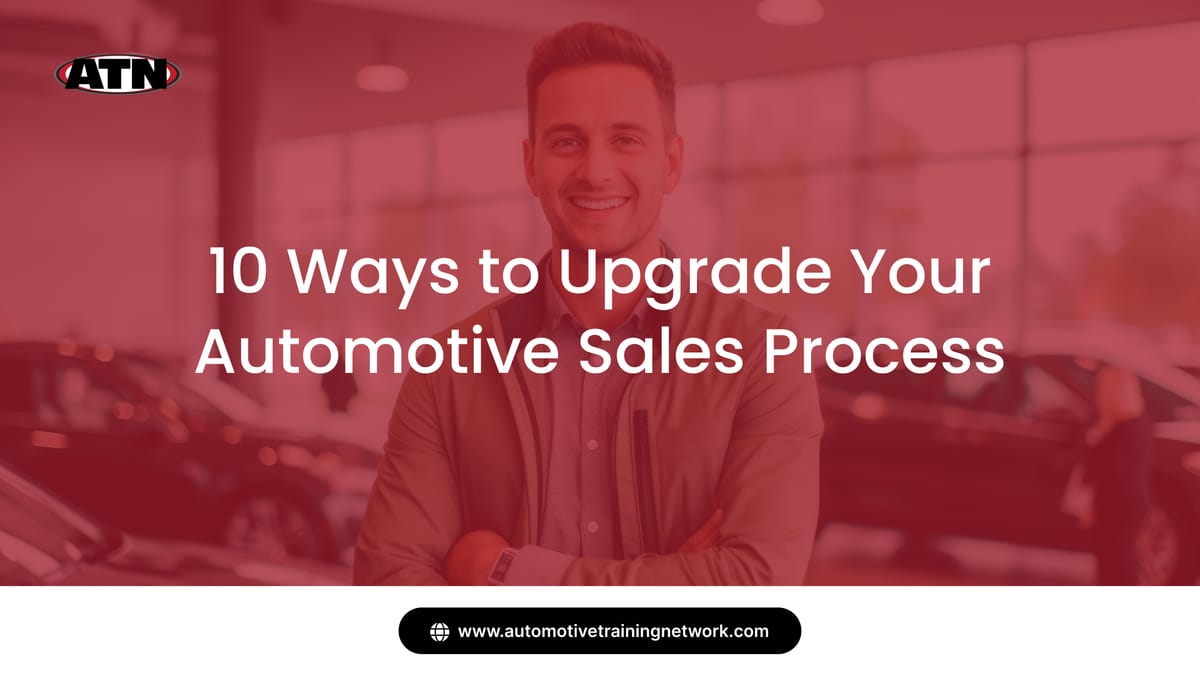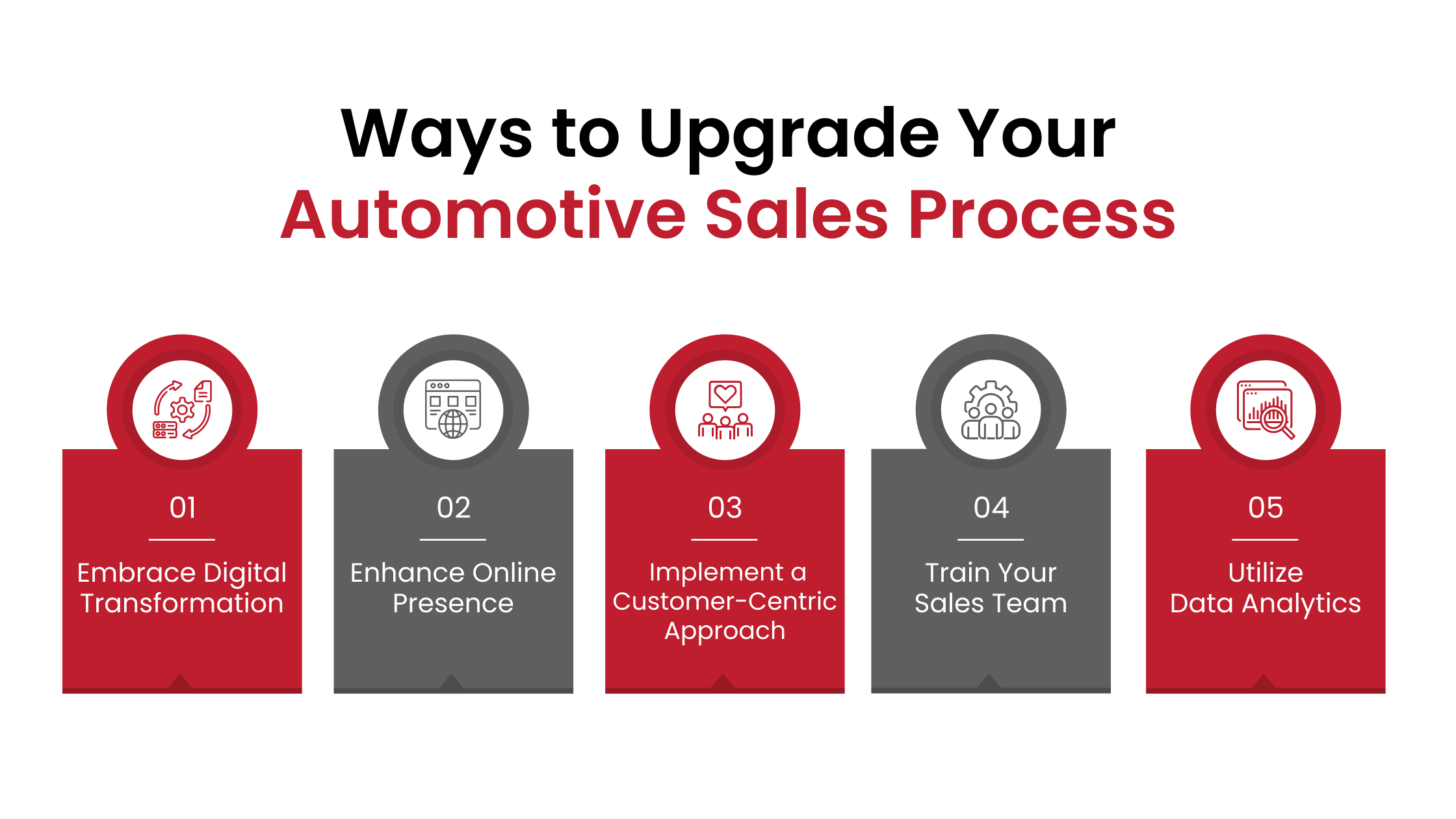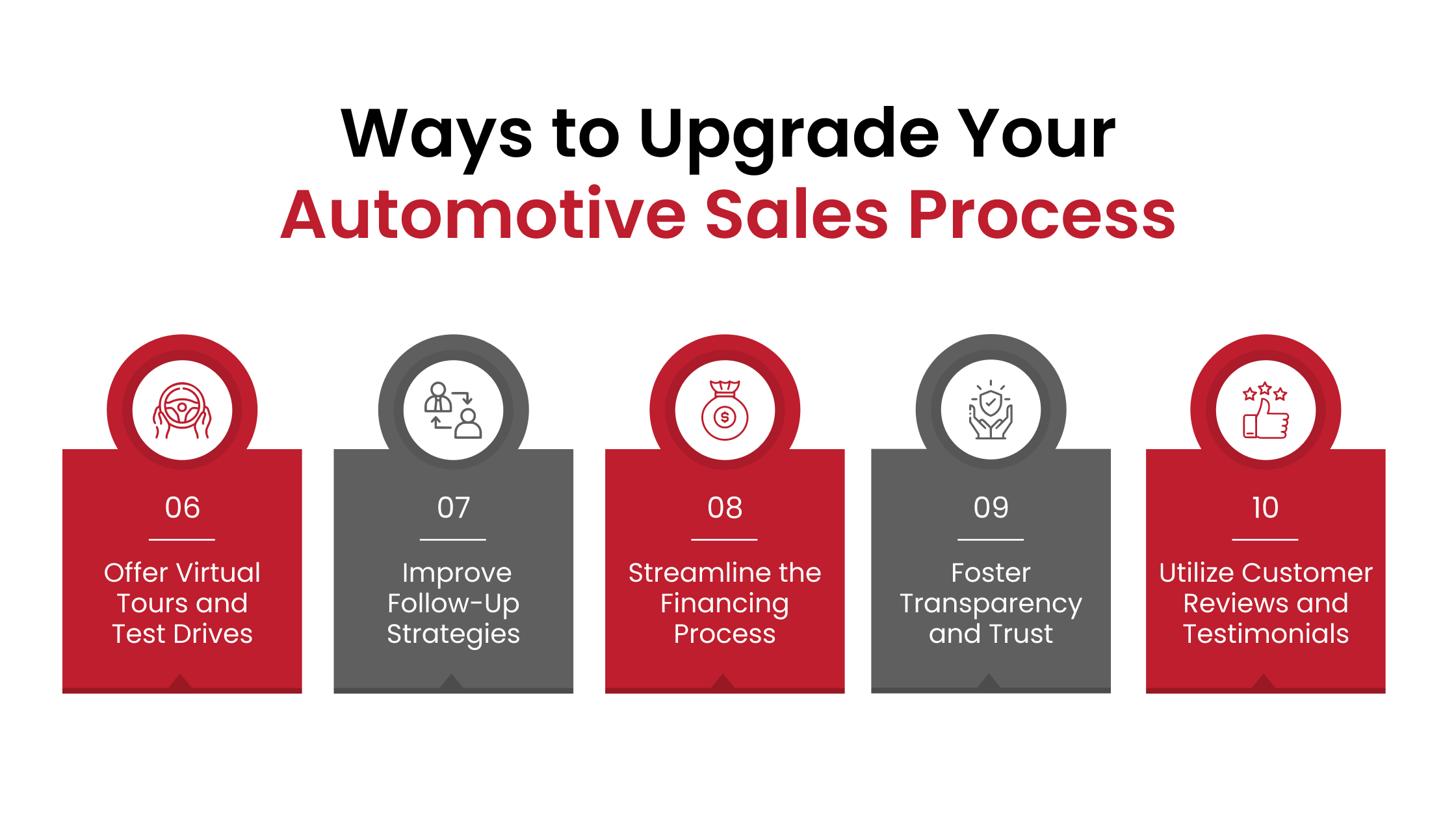10 Ways to Upgrade Your Automotive Sales Process

In 2023, the automotive sales industry accounted for 23% of all U.S. retail sales, proving that America’s love affair with cars is as strong as ever—and shows no signs of slowing down. This year, car sales are expected to surge even higher, with the passenger cars market estimated to reach a revenue of US$558.0 Billion in 2024.
However, the way people buy cars has dramatically shifted. Gone are the days of heading straight to a dealership. Today, a vast majority of car buyers, 95% to be exact, begin their search online. To stay competitive, automotive dealerships must adapt to these digital trends. While traditional sales techniques still matter, attracting online customers demands a broader strategy. This blog offers 10 ways to upgrade your automotive sales process, from utilizing digital tools to securing positive customer reviews.
Let’s explore how these strategies can enhance customer satisfaction, streamline operations, and boost your dealership’s car sales.
A Comprehensive List of 10 Ways to Upgrade Your Automotive Sales Process

1. Embrace Digital Transformation
Digital transformation isn’t just a necessity; it’s a gateway to a more efficient and customer-centric automotive sales process. Advanced digital tools can streamline operations, enhance customer engagement, and drive more sales, promising a brighter future for your dealership.
Here’s how you can gradually but effectively integrate digital tools into your automotive sales process steps to attract more customers:
i. CRM Software
A study found that dealerships can lose up to 37% of online leads due to missed follow-ups and CRM system issues. This reflects the urgent need for better CRM and automotive sales process training. A CRM system helps you keep track of customer information, interactions, and follow-ups, allowing your sales team to personalize communication and increase customer retention.
ii. Digital Marketing
Traditional marketing isn’t enough in today’s digital age. Effective digital marketing strategies, such as search engine marketing (SEM), social media ads, and email campaigns, can reach a broader audience. Target specific groups with ads and nurture leads with promotions or informative content like car maintenance tips.
iii. Offer Online Sales
Customers now expect the ability to explore cars, compare models, and even complete purchases online. An online sales platform with virtual showrooms, financing calculators, and chat support offers a comprehensive buying experience from the comfort of their homes.
2. Enhance Online Presence
Your online presence is often the first impression potential customers have of your dealership. A strong, well-managed online presence can attract more customers, build trust, and set you apart from competitors.
Here are a few enhancements you can make to your online presence to improve in-house sales in the long run:
i. Responsive Website Design
Did you know that automotive buyers typically visit at least 4.2 websites during their purchasing journey? Make an early and impactful impression with a responsive website to ensure your dealership stands out. Optimizing your website for mobile devices is essential, offering users a seamless browsing experience with fast load times, easy navigation, and quick access to critical information like inventory, pricing, and contact details.
ii. SEO and Content Marketing
Search Engine Optimization (SEO) is crucial for improving your dealership’s online visibility. By optimizing your website with relevant keywords like “automotive internet sales process,” creating informative blog posts, and consistently updating your content, you can improve your search engine rankings and attract more organic traffic.
Additionally, content marketing through blogs, videos, and infographics drives traffic and positions your dealership as an industry expert, building credibility and trust with your audience.
iii. Social Media Engagement
A recent study revealed that 1 in 3 social media-savvy buyers share their new vehicle purchases on social media. This behavior presents a prime opportunity for your dealership to connect with other new customers—as you can invent some new hashtags or ask your customers to “tag” or “follow” your social media pages.
Furthermore, maintaining an active social media presence allows you to post updates, share customer testimonials, and interact with followers, creating a vibrant online community. Social media also enables targeted advertising, allowing you to reach specific audiences based on their interests, location, and behavior, increasing your brand’s visibility and engagement.
3. Implement a Customer-Centric Approach
A customer-centric approach focuses on understanding and meeting each customer’s unique needs, ensuring a positive and memorable experience with your dealership.
Here’s how to give your customers a “not cut from the same cloth” experience:
i. Personalized Sales Experiences
Use data from CRM systems and other tools to tailor your auto sales process. Your dealership can also offer personalized vehicle recommendations based on previous inquiries or preferences and customize financing options to meet individual financial situations. This level of personalization can make customers feel valued and important in the sales process, increasing the likelihood of closing a sale.
ii. Customer Feedback Systems
Implement systems to collect customer feedback regularly, such as surveys or post-purchase follow-up calls. Analyzing this feedback can provide valuable insights into areas where your automotive sales process steps excel or need improvement. For instance, if customers consistently praise the friendliness of your staff, you can use this as a selling point in your marketing. On the other hand, if they express dissatisfaction with the waiting time, you can work on improving the efficiency of your service. Use this data to make informed adjustments that enhance the customer experience.
iii. Building Long-Term Relationships
Shift your focus from making a quick sale to building lasting customer relationships– this can be done by staying in touch through personalized communications, such as birthday greetings or maintenance reminders. Moreover, having a connection after the sale encourages repeat business and positive word-of-mouth referrals.
4. Train Your Sales Team
Continuous training is crucial to keeping your sales team at the top of their game. A well-trained team is more confident, knowledgeable, and better equipped to handle the diverse challenges of today’s automotive industry.
Here are ways to train your sales team effectively:
i. Regular Workshops and Seminars
Invest in ongoing education for your sales team by organizing workshops and seminars that cover the latest sales techniques, industry trends, and technological tools. These sessions can be led by industry experts and cover everything from advanced negotiation tactics to the latest features in electric vehicles.
Check out 6 Essential Skills to Become a Successful Car Salesperson for more insights on developing instrumental competencies.
ii. Role-Playing and Scenario-Based Training
Incorporate role-playing exercises into your automotive sales training. Your team can practice handling different customer objections, closing techniques, and cross-selling opportunities by simulating real-life sales scenarios in a safe, supportive environment. This hands-on practice can significantly improve their confidence and effectiveness in sales.
iii. Keeping Up with Industry Trends
The automotive industry constantly evolves, with new technologies, regulations, and consumer preferences emerging regularly. Ensure your team is well-informed about these changes by providing access to industry publications, online courses, and regular briefings. Staying updated lets your team offer customers the latest information and advice, enhancing their trust and your dealership’s reputation.
5. Utilize Data Analytics
Data analytics is a powerful tool for gaining insights into customer behavior, sales performance, and market trends, enabling you to make informed, strategic decisions.
Here’s how you can use data collected through CRM to improve sales:
i. Customer Behavior Analysis
Understanding your customers’ buying behavior is critical to refining your automotive sales process. You can identify patterns such as the most popular vehicle models, preferred financing options, and common pain points throughout the purchasing process by analyzing customer data. This insight allows you to tailor your sales strategies to meet your target audience’s specific needs and preferences, ultimately enhancing customer satisfaction and increasing sales.
ii. Sales Performance Metrics
Tracking and analyzing essential performance metrics is critical for identifying strengths and weaknesses in your auto sales process. By using call analytics, sales managers can identify these gaps and provide targeted coaching to ensure that agents are more proactive in securing appointments.
Additionally, by setting up email alerts for mishandled calls (if any), sales managers can quickly follow up to correct the issue, thereby recovering potential lost sales. Monitoring these and other metrics, such as conversion rates, average deal size, and sales cycle length, enables you to make data-driven adjustments that enhance overall performance.
iii. Predictive Analytics
Predictive analytics is a powerful tool for forecasting future sales trends, identifying potential leads, and optimizing inventory management. By anticipating which vehicles will likely be in demand, you can align your inventory more closely with customer preferences. This proactive approach reduces excess stock, improves turnover rates, and ensures that your dealership is always ready to meet market demand efficiently.

6. Offer Virtual Tours and Test Drives
As consumer preferences shift towards convenience and flexibility, offering virtual experiences can significantly enhance your dealership’s appeal.
i. Virtual Showroom Tours
Create immersive virtual showroom tours that allow customers to explore your inventory online. These tours can include 360-degree views of vehicles, detailed feature breakdowns, and interactive elements that let customers “sit” in the driver’s seat. Virtual tours can attract customers who may not have the time or inclination to visit in person, expanding your reach.
ii. Offer Test Drives
As car buyers increasingly make decisions online—evidenced by a 65% increase in watch time for “test drive” videos on YouTube—nonetheless, this stat hints that dealerships must adapt by offering more flexible test drive options. Consider providing home delivery for test drives, virtual test drives to showcase features online, and extended test drive periods to give customers ample time to evaluate a vehicle, all catering to the modern consumer’s demand for convenience.
7. Improve Follow-Up Strategies
Effective follow-up is crucial to converting leads into sales and maintaining strong customer relationships. A well-structured follow-up strategy ensures that no potential sale is lost due to a lack of communication.
Let’s take a look at how you can improve the “follow-up” game:
i. Automated Email and SMS Follow-Ups
Implement automated follow-up systems that send potential customers timely and relevant emails or SMS messages. These messages can include reminders about vehicles they’ve shown interest in, notifications about upcoming sales events, or tips on maintaining their current vehicle. Automation ensures consistency and helps keep your dealership top-of-mind.
ii. Personalized Follow-Up Calls
While automation is useful, nothing beats the personal touch of a phone call. Train your sales team to make follow-up calls tailored to each customer’s needs and interests. These calls can help address lingering questions, provide additional information, and reinforce the customer’s connection to your dealership.
iii. Post-Sale Follow-Ups for Feedback
After a sale, follow up with customers to gather feedback on their experience. This not only shows that you value their opinion but also provides you with actionable insights to improve your sales process. Additionally, post-sale follow-ups can be an opportunity to upsell additional services, such as extended warranties or maintenance packages.
8. Streamline the Financing Process
Financing is often a critical part of the vehicle purchase process. By making financing options clear and accessible, you can remove potential barriers and enhance the overall customer experience.
Listed below are some of the actionable tips on how you can make your financing experience better for the customers:
i. Online Financing Applications
Offer online financing applications that allow customers to pre-qualify for loans or lease options before they visit the dealership. This speeds up the buying process and gives customers a clear understanding of their purchasing power early on.
ii. Transparent Financing Terms
Ensure that all financing terms, including interest rates, loan durations, and monthly payment options, are communicated clearly and transparently. Customers are more likely to purchase when confident in their financial commitment.
iii. Collaborations with Multiple Financial Institutions
Partner with various lenders to offer your customers a range of financing options. This increases the likelihood that a customer will find a plan that fits their budget and improves your chances of closing the sale.
9. Foster Transparency and Trust
Building trust is fundamental to long-term success in automotive sales. Transparency in all aspects of the sales process helps establish credibility and fosters customer loyalty. Here’s how you can do it!
i. Clear Communication of Pricing and Offers
Be upfront about all costs, including taxes, fees, and optional add-ons. Avoid any hidden charges or last-minute surprises that can erode trust. As a trusted car dealership, you may also share special offers or discounts to ensure customers understand the deal’s value.
ii. Honesty About Vehicle History and Condition
Provide customers full disclosure about a vehicle’s history, including any previous accidents, repairs, or recalls. This transparency helps build trust and reassures customers that they are making an informed decision.
iii. Providing Detailed Vehicle Reports
Offer detailed vehicle reports from trusted sources like Carfax or Auto Check. These reports can provide customers with comprehensive information about a vehicle’s history, including ownership records, service history, and any reported accidents. Providing these reports upfront can increase customer confidence and facilitate quicker decision-making.
Moreover, you may also explore our Ultimate Guide to Automotive Reputation Management For Dealerships for a comprehensive approach to maintaining and enhancing your dealership’s reputation
10. Utilize Customer Reviews and Testimonials
Customer reviews and testimonials are powerful tools that can significantly influence potential buyers. By leveraging social proof, you can build credibility and attract more customers.
i. Encouraging Satisfied Customers to Leave Reviews
After a successful sale, encourage customers to leave a review on platforms like Google, Yelp, or your dealership’s website. Offer incentives, such as discounts on future services, to motivate customers to share their positive experiences.
ii. Highlighting Testimonials on the Website
Feature customer testimonials prominently on your website, especially on home, product, and contact pages. Positive testimonials can be powerful endorsements that build trust and encourage new customers to choose your dealership.
iii. Responding to Reviews (Positive and Negative)
Engage with all customer reviews, whether positive or negative. Thank customers for positive feedback and address any concerns raised in negative reviews with a constructive, solution-oriented approach. Responding to reviews shows that you value customer feedback and are committed to continuous improvement.
Upgrading your automotive sales process is not just about staying competitive—it’s about thriving in a rapidly changing market. By embracing digital transformation, enhancing your online presence, and adopting a customer-centric approach, you can create a seamless and satisfying buying experience that sets your dealership apart. Implementing these 10 strategies will improve your auto sales process outcomes and build long-term customer relationships, driving repeat business and positive word-of-mouth.
Upgrade Your Automotive Sales Process with ATN

A well-trained and knowledgeable sales team is the backbone of any successful automotive dealership. The Automotive Training Network (ATN) can be your trusted partner in empowering your team to excel at every step of the automotive sales process, from fostering authentic customer relationships to closing deals with confidence.
With 40 years of industry experience, ATN provides a full range of training solutions designed to meet your dealership’s specific needs, including:
Our data-driven approach ensures your sales team is equipped with cutting-edge industry knowledge and proven strategies, all tailored to your dealership’s unique goals. Experience the powerful impact of ATN’s expert training on your team and dealership performance.
